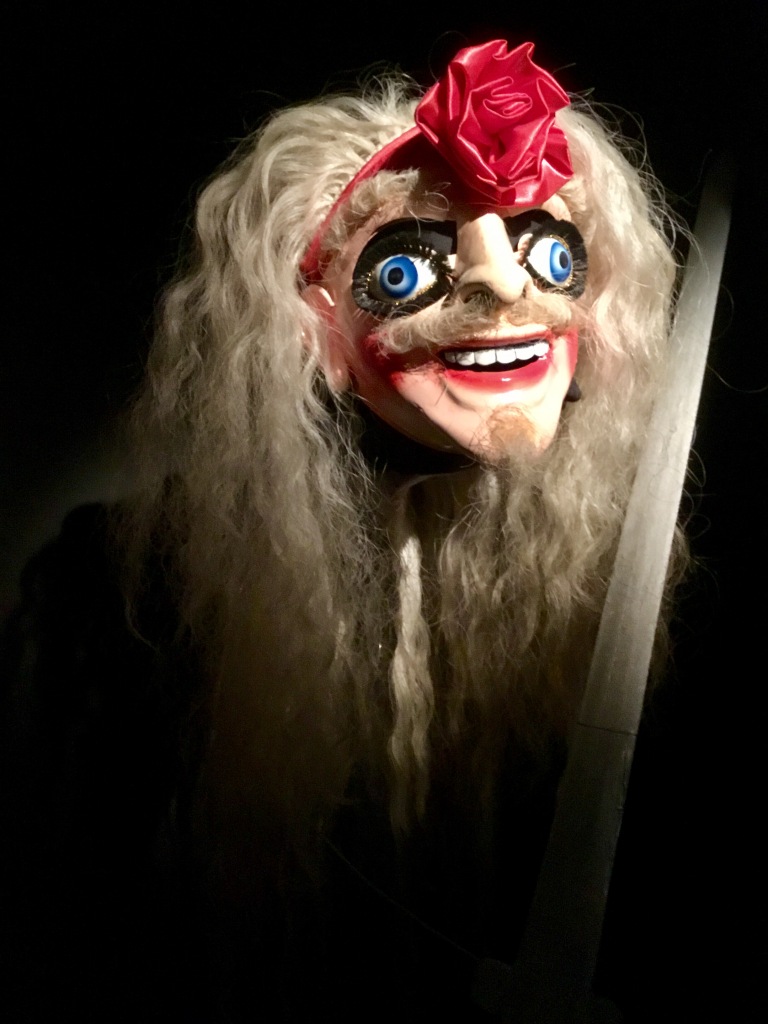Q: What art project(s) are you working on currently? What is your inspiration or motivation for this? (Question from artamour)

A: While traveling in Bolivia in 2017, I visited a mask exhibition at the National Museum of Ethnography and Folklore in La Paz. The masks were presented against black walls, spot-lit, and looked eerily like 3D versions of my Black Paintings, the series I was working on at the time. I immediately knew I had stumbled upon a gift. To date I have completed seventeen pastel paintings in the Bolivianos series. One awaits finishing touches, another is in progress, and I am planning the next two, one large and one small pastel painting.
The following text is from my “Bolivianos” artist’s statement.
“My long-standing fascination with traditional masks took a leap forward in the spring of 2017 when I visited the National Museum of Ethnography and Folklore in La Paz, Bolivia. One particular exhibition on view, with more than fifty festival masks, was completely spell-binding.
The masks were old and had been crafted in Oruro, a former tin-mining center about 140 miles south of La Paz on the cold Altiplano (elevation 12,000’). Depicting important figures from Bolivian folklore traditions, the masks were created for use in Carnival celebrations that happen each year in late February or early March.
Carnival in Oruro revolves around three great dances. The dance of “The Incas” records the conquest and death of Atahualpa, the Inca emperor when the Spanish arrived in 1532. “The Morenada” dance was once assumed to represent black slaves who worked in the mines, but the truth is more complicated (and uncertain) since only mitayo Indians were permitted to do this work. The dance of “The Diablada” depicts Saint Michael fighting against Lucifer and the seven deadly sins. The latter were originally disguised in seven different masks derived from medieval Christian symbols and mostly devoid of pre-Columbian elements (except for totemic animals that became attached to Christianity after the Conquest). Typically, in these dances the cock represents Pride, the dog Envy, the pig Greed, the female devil Lust, etc.
The exhibition in La Paz was stunning and dramatic. Each mask was meticulously installed against a dark black wall and strategically spotlighted so that it became alive. The whole effect was uncanny. The masks looked like 3D versions of my “Black Paintings,” a pastel paintings series I have been creating for ten years. This experience was a gift… I could hardly believe my good fortune!
Knowing I was looking at the birth of a new series – I said as much to my companions as I remained behind while they explored other parts of the museum – I spent considerable time composing photographs. Consequently, I have enough reference material to create new pastel paintings in the studio for several years. The series, entitled “Bolivianos,” is arguably my strongest and most striking work to date.”
Comments are welcome!
Posted on March 19, 2022, in 2022, An Artist's Life, Bolivia, Bolivianos, Creative Process, Inspiration, Pastel Painting, Source Material, Travel and tagged "National Museum of Ethnography and Folklore, "The Champ", "The Diablada", "The Incas", "The Morenada", "Black Paintngs", against, Altiplano, animals, another, arguably, arrived, artist's statement, assumed, Atahualpa, attached, “Avenger”, became, behind, believe, Bolivia, Bolivianos, Carnival, celebrations, Christian, companions, completed, complicated, composing, consequently, considerable, created, dances, depicts, derived, devoid, different, disguised, dramatic, eerily, elements, elevation, emperor, entitled, except, exhibition, experience, explored, fascination, February, female, festival, fighting, figures, finishing, folklore, following, former, fortune, forward, happen, immediately, important, Indians, installed, knowing, La Paz, latter, long-standing, looked, looking, Lucifer, material, medieval, meticulously, mitayo, museum, originally, Oruro, particular, pastel paintings, permitted, photographs, planning, pre-Columbian, presented, records, reference, remained, represent, revolves, Saint Michael, series, seven deadly sins, several, Source Material, Spanish, spell-binding, spot-lit, spotlighted, strategically, striking, strongest, stumbled, stunning, symbols, The Conquest, tin-mining, totemic, traditional, traditions, traveling, typically, uncanny, uncertain, versions, visited, worked, working. Bookmark the permalink. Comments Off on Q: What art project(s) are you working on currently? What is your inspiration or motivation for this? (Question from artamour) .
